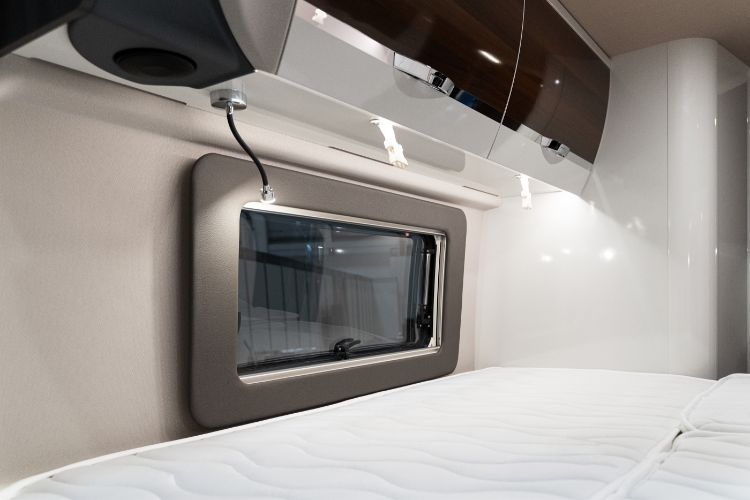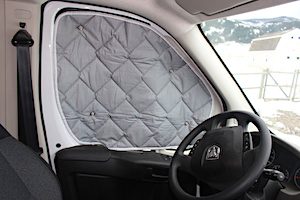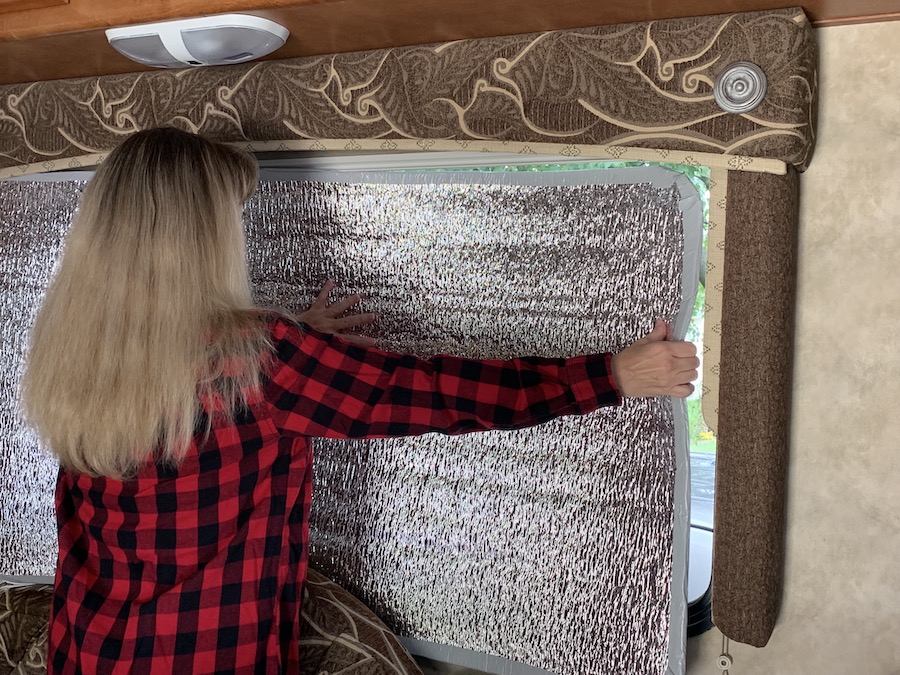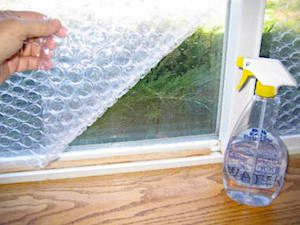Thanks for your support! If you make a purchase using our links in this article, we may make a commission. And, as an Amazon Associate, I earn from qualifying purchases. See the full disclosure here.
Updated April 15, 2024
Summers can bring scorching heat, making the inside of your RV feel like an oven. Cold weather can make sitting in your camper a bone-chilling experience.
We have stayed in both hot and cold weather conditions, so we made our own window insulation covers for summer or winter!
Most trailers have single-pane windows. And, one of the most significant sources of heat loss for your RVs is these same single-pane windows. While glass is a reasonably good insulator, a single-pane window does not contain enough glass to do the job. However, single-pane windows are easy to manufacture and inexpensive to install, and this is why trailer manufacturers use them.
With single-pane windows, heat loss in the winter and heat gain in the summer will make your camper uncomfortable. You will also experience higher heating and cooling costs, not to mention the wear and tear on your RV’s heating and cooling systems.
You could certainly replace the single-pane windows with double-pane windows, but there are several reasons you might not want to do that. The first is that it could be expensive, and the second is that modifying your trailer to that extent could void your warranty.
Several other options for insulating your RV’s windows are available that work well, provide flexibility, and are relatively inexpensive.
- How Does RV Window Insulation Work?
- Should the RV Window Insulation Go on the Inside or Outside?
- Homemade RV Window Covers
- Do RVs Have Double-Pane Windows?
- Can You Upgrade RV Windows To Double Pane?
- Can You Get Insulated RV Curtains?
- How to Make Insulated RV Window Curtains
- Plexiglass RV Window Insulation
- Shrink Wrap Your RV Windows
- Reflectix for RV Window Insulation
- Can RV Window Tinting Help Insulate an RV?
- Final Words About RV Window Insulation
- Related Reading:
- Mike Scarpignato – Bio
How Does RV Window Insulation Work?
Window insulation products create a barrier to help prevent heat loss in cold weather. They can also help prevent heat gain in hotter weather. Insulating your RV’s windows against heat loss or gain will help you stay cooler in the summer and warmer in the winter.
Also, moisture in the RV can condense on colder window surfaces. This condensation can lead to mold or mildew problems as well. Two ways to decrease the humidity in your RV are to either lower the moisture level by using a dehumidifier or increase airflow. However, increasing airflow can create other issues depending on current weather conditions.
The main point here is that, if your single-pane windows feel cold to the touch, that means heat is escaping through them. It also means your RV probably feels drafty and your heating costs are going to be higher. So, let’s take a look at insulating those drafty RV windows.
Should the RV Window Insulation Go on the Inside or Outside?
If you are using insulated RV window curtains, placing them on the outside would be silly at best. However, one of the most effective ways to improve window insulation is to use bubble wrap with a layer of foil (also known as Reflectix) on either side.
Placing the Reflectix on the inside of your RV windows, especially when it’s scorching hot outside, can cause the window to heat up to the point of cracking. The best way to prevent your RV’s windows from heating up is to place this type of insulation on the outside. Placing window insulation such as this on the inside can also contribute to condensation problems.
Homemade RV Window Covers
Homemade window covers are another great way to insulate your RV’s windows. An excellent window cover would be the combination of Reflectix and bubble wrap mentioned earlier and recommend for use on the outside of your RV’s windows.
You can also use bubble wrap by itself on the inside. To insulate a window with bubble wrap, dampen the glass and stick the bubble wrap to it. The bubble side of the wrap will be facing the glass. Just try to find bubble wrap that comes in 24″ wide rolls rather than 12″ or you will find yourself taping the bubble wrap together to cover most of your windows. Also, make sure the bubble wrap is at least 5/16″ thick. The thicker the better.
Use a spray bottle or a damp rag to moisten the window. Adding a little dish soap will help the bubble wrap stick even better. This method requires you to keep the bubble wrap on the windows all winter. However, if it comes loose, you can dampen the glass again and stick it right back up. You can also use clear tape to tape two or more pieces of bubble wrap together for bigger windows.
An advantage of using bubble wrap alone is that it still lets light through the window. However, seeing clearly through the window is out of the question.
Do RVs Have Double-Pane Windows?

Double-pane windows are great for adding extra insulation to your RV, and as such, many RVs do have them.
For some trailers, double-pane windows will come standard. This is especially the case when the RV is billed as all-season or four-season, as double-pane windows help keep things cozy in the cold. But, even then, it’s no guarantee.
Rather, in many cases, double-pane windows are available as an optional upgrade for your RV. If you’re expecting to camp mostly in warm or mild weather, that upgrade may not be worth it. But if you want to do winter RVing, the extra cost is justified.
Can You Upgrade RV Windows To Double Pane?
If your RV has single-pane windows and you want to upgrade to double-pane, it’s definitely possible. You can have a professional do the installation, but it’s not too difficult in most cases to DIY it.
The exact process will vary depending on the RV and the window, but it will look something like this:
- Remove the old window by removing the screws on the trim ring inside the RV, then push the window out with force.
- In some cases, sealant will be under the window flange outside the vehicle; to remove this, work around it with a thin putty knife to loosen it in one corner, then push the corner of the window out of the hole.
- Next, place the new window in the opening to ensure it fits, then remove it to prepare for installation.
- With the window lying face down on a soft surface, apply seal tape to the flange, starting in the middle of the bottom of the window. Ensure the ends overlap by about a half inch. Remove the backing off the tape.
- Insert the window into the opening, have a helper hold it in place, then center the clamp ring and install the provided screws.
Can You Get Insulated RV Curtains?
Insulated curtains are another option for increased insulation. Insulated curtains made specially for RVs can be purchased from brands like Blackout EZ, or use residential curtains.
Another option is to make your own insulated RV curtains. There are several ways to do this, but the general process involves sowing together insulating material like Insul-Bright with a sturdy fabric that ideally blocks light, then adding a velcro strip to the curtain and above the window you want to cover. Then, simply stick on the window cover.
How to Make Insulated RV Window Curtains

Another low-cost way to help insulate your RV’s windows is to make insulating RV curtains. Making these curtains is also relatively simple if you are handy with a sewing machine. To get started you will need some good quilted material such as a mattress cover for the exterior layer, an inexpensive liner material such as sheets for the interior layer, and heavy-duty aluminum foil for the middle layer.
First, measure windows to determine the curtain sizes. Then use the mattress cover for the outside layer, the foil for the middle layer, and the liner or sheet for the inside layer. Bind them all together. Also, you can use a foil tape like that used by HVAC companies use to attach foil or Reflectix for larger windows. If you want to get fancy, use carpet edge tape to cover the outside edges giving your curtains a more finished look.
The insulated RV curtains can be hung between the blinds and the window, and will significantly reduce heat loss in cold weather as well as help keep the heat out in the summer.
Plexiglass RV Window Insulation
Plexiglas window covers can be an excellent choice for larger windows. You can purchase plexiglass sheets from almost any building supply store. Plexiglass is easy to cut with a utility knife, and you can use clear acrylic mounting tape or even Velcro to hold it in place.
Plexiglass covers allow critical insulative air space while still allowing an unobstructed view through the windows. However, plexiglass can be a bit more expensive than other options, costing around $45 for a 0.080″ x 24″ x 48″ sheet.
Shrink Wrap Your RV Windows
Another possibility is to use a window insulator kit. These are the same heat-shrink plastic kits people use to insulate their windows at home during the winter. You place a double-sided tape (typically included in the package) around the window frame. You then cover the window with plastic by sticking it to the tape.
Using a hairdryer, you heat the plastic, which shrinks, smoothing out all of the wrinkles. The tape forms a seal around the edges, trapping a layer of air between the plastic and the glass. Again, this layer of air provides insulation against the cold, helping you stay warm.
Reflectix for RV Window Insulation
Another popular choice is to cover your RV windows with Reflectix. Reflectix has excellent insulative properties. However, if sunlight is key to your sense of well-being, this may not be the best option for you. As its name suggests, Reflectix reflects the sunlight away and will not let it through.
Reflectix may help insulate your RV, but it also repels a useful source of heat in colder weather: the sunlight mentioned above.
Because of this, many RVers put Reflectix in their windows at night and take it out during the day. Removing it allows the sun to warm the RV during the day. The problem here is that you have to take it down and put it back up daily. Also, sitting next to a single-pane window on a cold day can be a drafty experience. Some of those methods mentioned above may be better methods for insulating your RV’s windows.
Can RV Window Tinting Help Insulate an RV?
Tinting your RV windows can certainly help keep the heat out in the summertime. In fact, some of the more advanced window films can also help keep heat inside your RV.
For much more information about how tinting your RV Windows can help insulate your RV check out our helpful article called RV Window Tinting – Increase Privacy and Reduce Heat.
RELATED READING: Check out our artcile How Long Does an RV Propane Tank Last (Heat, Fridge, Water) for a deep dive into propane use.
Final Words About RV Window Insulation
As you can see, many ways to insulate your RV’s windows exist. These different options range from simple and cheap to more expensive and complicated. Some may actually be quite fun for the handy do-it-yourselfer.
Adding an insulation layer to your RV’s windows can significantly increase your RV’s comfort level while reducing your heating and cooling bills. It can also reduce the wear and tear on your heating and AC systems, prolonging their service life.
And, you can utilize many of these options full-time, keeping your RV’s comfort zone on your open-road adventures much more consistent.
Do you have some creative ways you have insulated your RV from hot or cold weather? Please share your comments below! We would love to hear from you!
For more related information check out some of our other helpful articles below:
Related Reading:
– AirSkirt Inflatable RV Skirting for Winter and Summer
– RV Window Tinting – Increase Privacy and Reduce Heat
– DampRid vs Dehumidifier – How to Reduce Humidity in an RV
– Is it Safe To Leave a Pet in an RV?
Mike Scarpignato – Bio
Mike Scarpignato created RVBlogger.com over five years ago in 2018 to share all we have learned about RV camping.
Mike is an avid outdoorsman with decades of experience tent camping and traveling in his 2008 Gulf Stream Conquest Class C RV and 2021 Thor Challenger Class A motorhome.
We attend RV Shows and visit RV dealerships all across the country to tour and review drivable motorhomes and towable trailers to provide the best evaluations of these RVs in our blog articles and YouTube videos.
We are 3/4-time RVers who created RVBlogger.com to provide helpful information about all kinds of RVs and related products, gear, camping memberships, tips, hacks and advice.





What is one of the best dehumidifier for my 32 foot travel trailer? Need one now?!!
Thanks
Lorey
How do you attach the reflextix to your camper windows on the inside.???
I want to have plexiglass put as a second barrier for my windows. I saw where they used magnetic tape to secure it to the windows and want to do that. I would like your opinion on that. Also, do you get condensation between the window and the plexiglass if there is a good seal? If so how do I prevent that?
I have installed Reflectix on several of my 5th wheel windows recently, and am amazed in the results of keeping the heat in. Especially the the 2 windows next to the bed. I actually covered the whole wall behind the bed and it made a huge difference. My only problem is I was hoping it would eliminate the condensation, especially on the door windows, which runs down the inside of the door and starts to rust out the bottom. Do you know if I have installed it wrong or does it not stop the condensation? I only used 6 squares of Velcro to secure onto the window frame and not sealed completely nor touching the window.
Let me know your thought or advice.
Hi Jay,
If you have condensation forming inside your RV you have too much humidity inside. So, you either need to vent the air better to get rid of moisture from showering and cooking and from you just breathing or you need a good dehumidifier. That should do the trick.
Please let me know what you decide to do and how it works for you.
Thanks for reading the article!
Safe travels,
Mike
I’ve just been researching this topic as I’ve moved my fifth wheel to a much colder climate and need to prepare for winterizing in a few months. Condensation is one of my concerns for this upcoming winter. I’ve read people have had better luck keeping condensation down when the reflective barrier is on the outside of the window as well as the inside.
Try leaving the bathroom vent open. It allows any buildup of humidity to escape while not creating an excessive loss of heat or cooling. Once I started doing this, I haven’t had any more problems with humidity build up and mildew on my windows.
Alan